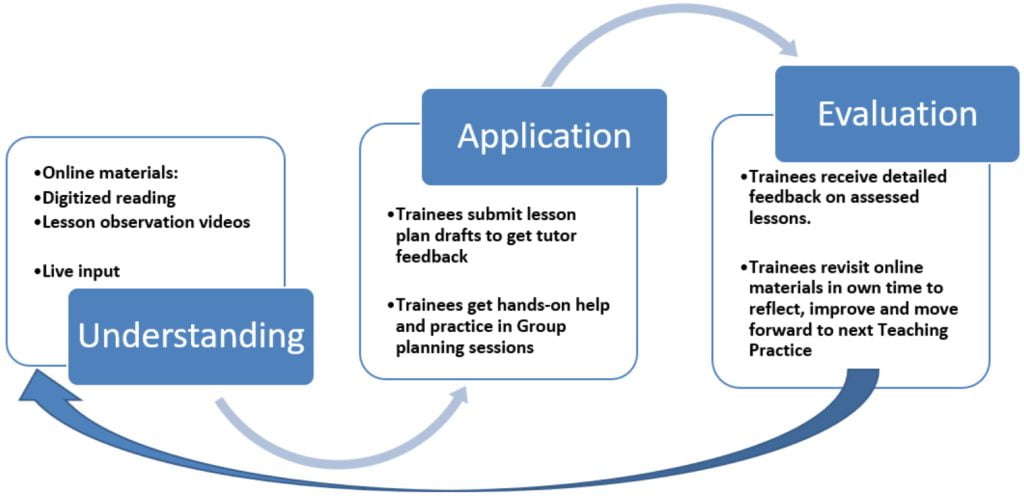Mixed mode learning is a progressive approach to education and training. Put simply, it combines online learning with aspects of more traditional face-to-face learning experiences.
Mixed mode learning is also known as hybrid and blended learning but there are many different definitions, interpretations and ways of implementing each of these. It’s important to develop a model that works for the learning context that you are in so that the learning opportunities you offer
are enhanced.
What is the model for the mixed mode CELTA at Melbourne Training International?
At MTI, our mixed mode, full-time CELTA gives trainees the practical experience in both the online and face-to-face classrooms. This gives our CELTA graduates the best of both worlds in terms of training and also makes them more competitive in today’s job market. Since the pandemic, schools
and universities need teachers who are able to teach in both contexts. This is because more and more schools are offering hybrid English courses to keep up to date with current demands, teaching trends and learner needs.
On the MTI mixed mode course, trainees complete their online teaching assessments during half of the course. During this time, they develop not only their English teaching skills but also their ability to use technology in the online classroom. In the other half of the course, they complete their
teaching practice in the f2f classroom, where they can refine these skills in person with the students.
The input for the course is all conducted online and is based on the flipped learning method. In this methodology model, the CELTA trainees first work through the online lesson observations and digitized reading materials each week. This allows them to comprehend and reflect on the learning
material and theories at their own pace. This is complemented by online live input sessions, which are staggered throughout the course. These sessions provide trainees with real-time engagement and a sense of community with their peers and trainers. Then, the trainees apply their knowledge in lesson plan drafts on which they get detailed feedback from the tutors. This is in addition to group planning sessions where they can get hands-on help and practice before delivering their assessed lesson. On top of this, trainees are encouraged to ask questions during live input sessions, lesson plan drafts, group planning sessions or via online support offered throughout the course.
(This flipped learning model is based on Blooms Taxonomy)

The purpose of mixed mode learning is to combine the best of face-to-face and online learning into one enhanced learning experience. There are numerous benefits to this – see our Google Reviews:
- Gaining practical experience in both the face-to-face and online classroom
- Trainees learn effective techniques for teaching in both contexts and gain more awareness of diversity and learner needs
- Trainees are prepared to teach in schools that offer both formats, making them more competitive
- Learning how to use a range of technology that can be utilised in both the online and f2f classrooms
- Trainees and English students all gain new, transferable technology skills
- Trainees know how to conduct paperless classes
- More autonomy, control and flexibility for adult learners
- Trainees can work through the input at their own pace
- Flipped learning gives adult learners more time to reflect on the materials before being assessed in their Teaching Practice
- Materials are always available online offering more flexibility and inclusivity
- Trainees can revisit any of the observations, readings or recorded live inputs at any time during the course
- A more inclusive approach to suit trainees’ personal schedules
- Online materials and interactions cater for different learning preferences
- Variation in materials (videos, reading, interactive live input, group planning sessions) and interactions increases engagement and learning
- More efficient use of time and resources for trainers
- Tutors have more time to connect with trainees in more personal and impactful ways
- Tutors can take a more tailored approach to fill in knowledge gaps during the lesson plan
What do universities and English schools say about graduates with experience of online and face-to-face teaching?
“We’ve been really impressed with the 21st century skills for teaching online and hybrid classes and the ability of the MTI CELTA graduates to build digital literacy for academic tasks.”Paul Williams, Senior Teacher at CQUniversity Melbourne
“Our classes are face-face but it is a great advantage if teachers are familiar with teaching online, as more experienced teachers often lack this.”Cameron Winton, Academic Manager at Discover English
“We are running a combination of hybrid and pure face-to-face classes so it’s great to have graduates who can teach both.”Patrick (Paddy) Rizio, Assistant Academic Manager at Greenwich College
How to enrol in a CELTA course at MTI
We’re here and happy to help you with any questions or concerns about doing the Cambridge CELTA
course. You can contact us anytime by calling, emailing or visiting our website or you can apply here
now.
We also have frequent, free Information Nights which you can attend to find out more about the
CELTA and meet one of our friendly trainers.
